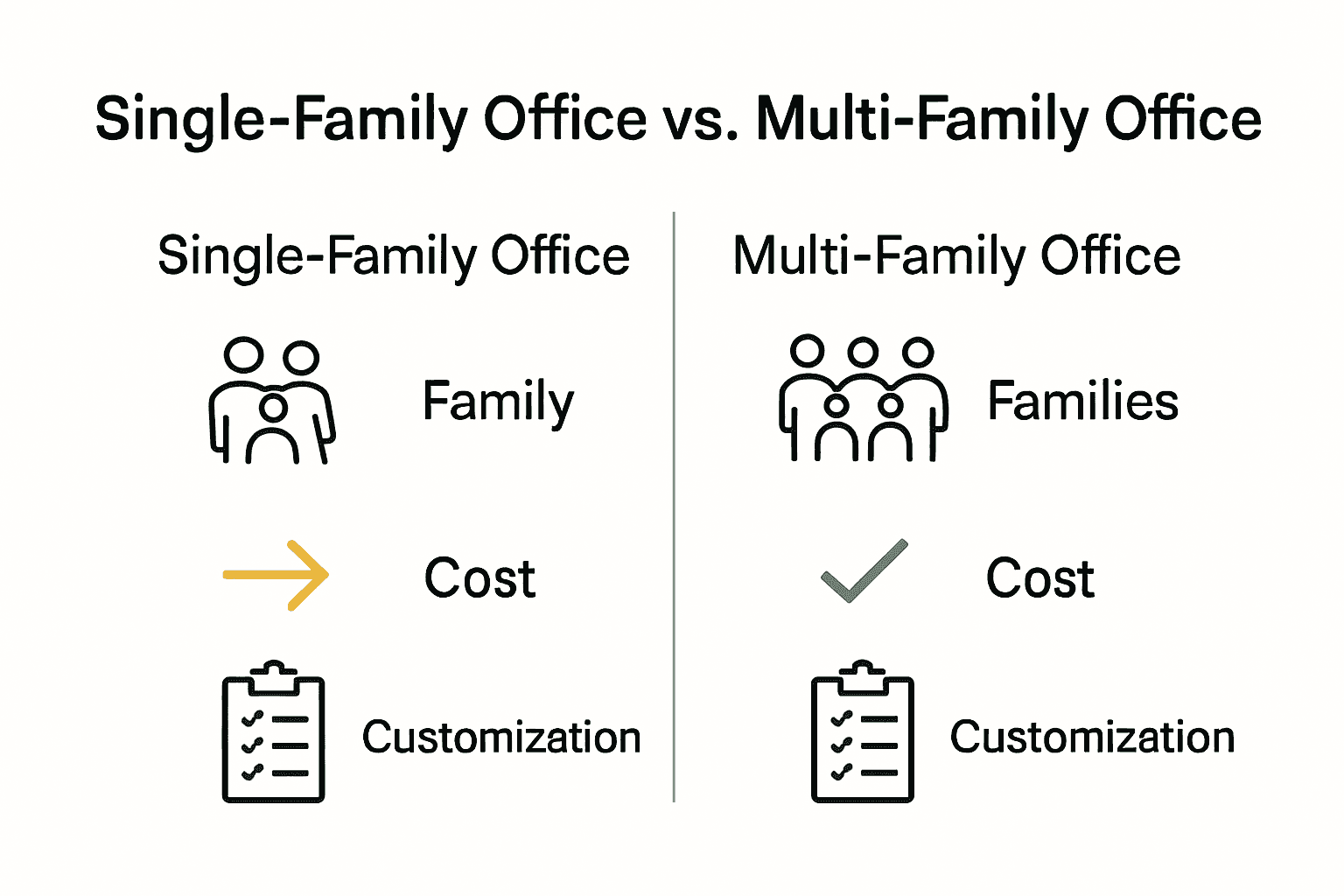More than $84 trillion in wealth is expected to transfer between generations in the next two decades, reshaping how ultra-wealthy families preserve and grow their assets. As fortunes become more complex, understanding effective wealth management best practices matters more than ever. Mastering proven financial strategies empowers individuals and family offices to protect, enhance, and pass on their legacy in a rapidly changing world.
Key Takeaways
| Point | Details |
|---|---|
| Wealth Management Best Practices | Systematic approaches improve financial strategies for ultra-high-net-worth individuals by leveraging goal setting, risk management, and performance benchmarking. |
| Types of Wealth Management Services | Services cater to unique needs, ranging from investment management to estate planning, emphasizing personalized and strategic wealth solutions. |
| Core Strategic Components | Effective wealth management relies on dynamic frameworks that integrate risk assessment, performance forecasting, and adaptive portfolio management to achieve client objectives. |
| Avoiding Common Mistakes | Investors should proactively recognize and address pitfalls like insufficient diversification and emotional decision-making to maintain robust financial strategies. |
Table of Contents
- Defining Wealth Management Best Practices
- Types of Wealth Management Services
- Core Components of Effective Strategy
- Regulatory Standards and Global Frameworks
- Risk Management and Cost Considerations
- Common Mistakes and How to Avoid Them
Defining Wealth Management Best Practices
Wealth management best practices are systematic approaches designed to help ultra-high-net-worth individuals and family offices optimize their financial strategies and decision-making processes. Best practices represent methods and techniques that have been proven superior in delivering consistent, high-quality outcomes across complex financial landscapes.
According to Wikipedia’s best practice definition, a best practice is fundamentally a method that tends to produce superior results compared to mandatory standards. In wealth management, these practices often involve comprehensive frameworks that enable:
- Rigorous financial goal setting
- Advanced risk management techniques
- Strategic portfolio diversification
- Continuous performance benchmarking
- Adaptive financial decision-making models
Recent academic research from advanced computational studies explores innovative approaches to wealth management best practices. Research published in academic archives suggests that modern wealth management increasingly relies on sophisticated techniques like deep reinforcement learning to achieve clients’ financial objectives. These cutting-edge methodologies move beyond traditional investment strategies, incorporating data-driven insights and predictive modeling to create more personalized and precise wealth management solutions.

Ultimately, wealth management best practices are not static rules but dynamic, evolving strategies that adapt to changing market conditions, individual client needs, and emerging technological capabilities. The most successful practitioners blend systematic approaches with flexible, intelligent decision-making frameworks that can navigate complex financial environments with precision and strategic foresight.
Types of Wealth Management Services
Wealth management services represent sophisticated financial solutions tailored for ultra-high-net-worth individuals and family offices, offering comprehensive strategies that extend far beyond traditional investment management. These services are designed to provide holistic financial support across multiple complex domains, ensuring integrated and strategic wealth preservation and growth.
According to Wikipedia’s family office research, single-family offices provide centralized management of significant family wealth through specialized services including:
- Investment management strategies
- Tax planning and optimization
- Estate legal affairs coordination
- Family governance frameworks
- Philanthropy program development
- Multi-jurisdictional financial planning
- Succession strategy implementation
Research on multi-family offices reveals another critical service model supporting multiple affluent families through integrated professional services. These sophisticated platforms offer comprehensive solutions such as:
Here’s a comparison of single-family offices and multi-family offices:
| Feature | Single-Family Office | Multi-Family Office |
|---|---|---|
| Client Base | One family | Multiple families |
| Service Customization | Highly personalized | Customized, but more standardized |
| Cost Structure | High fixed costs | Shared costs |
| Scope of Services | Comprehensive, holistic | Broad, integrated |
| Professional Network | Exclusive, in-house | Shared, external partnerships |
| Legacy & Governance | Family-controlled frameworks | Standardized with some flexibility |
| Typical Use Case | Very high net worth, unique needs | Affluent families, efficiency focus |

- Strategic investment advisory
- Comprehensive estate planning
- Advanced tax mitigation techniques
- Professional network coordination
- Trusteeship management
- Lifestyle administration services
- Philanthropic foundation management
Beyond traditional models, modern wealth management services are increasingly leveraging technology, data analytics, and personalized approaches to deliver more nuanced, adaptive financial solutions. The most effective services now blend deep financial expertise with technological innovation, creating customized strategies that anticipate and address the unique economic landscapes and personal objectives of each client.
Core Components of Effective Strategy
Wealth management strategy is a sophisticated framework that transforms complex financial planning into precise, goal-oriented action. At its core, an effective strategy represents a dynamic roadmap that adapts to changing economic landscapes while maintaining laser-focused alignment with client objectives and long-term financial aspirations.
Research from advanced computational studies reveals that modern wealth management strategies are increasingly employing sophisticated techniques like deep reinforcement learning. These cutting-edge approaches enable sequential optimization of investment decisions, allowing for more intelligent and adaptive financial planning. Key strategic components typically include:
- Comprehensive financial goal mapping
- Adaptive risk assessment models
- Predictive performance forecasting
- Personalized investment allocation
- Dynamic portfolio rebalancing
- Strategic tax optimization
- Continuous performance monitoring
According to best practice methodologies, effective strategies are fundamentally about creating structured, quality-driven processes that align meticulously with individual client needs. This means moving beyond generic investment approaches and developing nuanced, tailored strategies that consider unique financial contexts, risk tolerances, and long-term family wealth preservation objectives.
The most successful wealth management strategies embrace flexibility, technological innovation, and data-driven insights. They recognize that financial planning is not a static process but a continuously evolving journey requiring persistent refinement, proactive risk management, and a holistic understanding of both macroeconomic trends and individual client dynamics.
Regulatory Standards and Global Frameworks
Global regulatory frameworks serve as critical foundations for maintaining integrity, transparency, and stability within the wealth management ecosystem. These comprehensive standards provide essential guidelines that protect investors, ensure ethical practices, and create consistent benchmarks for financial institutions operating across international markets.
Basel III, an international regulatory framework, represents a pivotal example of global financial governance. This sophisticated standard establishes crucial parameters for:
- Bank capital adequacy requirements
- Comprehensive stress testing protocols
- Advanced liquidity management standards
- Risk mitigation strategies
- Financial stability mechanisms
- Institutional resilience frameworks
- Global banking transparency standards
The Equator Principles demonstrate another critical dimension of modern regulatory frameworks, focusing on environmental and social risk management in project finance. These principles illustrate how wealth management is increasingly integrating broader considerations beyond traditional financial metrics, emphasizing:
- Responsible investment practices
- Environmental risk assessment
- Social impact evaluation
- Sustainable development criteria
- Ethical investment screening
Ultimately, global regulatory standards are not static documents but dynamic frameworks that evolve alongside technological innovations, geopolitical shifts, and emerging economic challenges. The most effective wealth management strategies recognize these frameworks as essential guardrails that provide structure, promote accountability, and create trust in increasingly complex global financial landscapes.
Risk Management and Cost Considerations
Risk management represents the critical backbone of sophisticated wealth preservation strategies, transforming potential financial vulnerabilities into strategic opportunities for ultra-high-net-worth individuals and family offices. This complex discipline goes far beyond simple protection, involving intricate analysis, proactive planning, and dynamic adaptation to evolving economic landscapes.
Basel III regulatory frameworks provide foundational insights into robust risk management approaches. These international standards emphasize critical protective mechanisms including:
- Comprehensive capital buffer requirements
- Strategic liquidity controls
- Advanced leverage management
- Systematic risk assessment protocols
- Proactive financial shock mitigation
- Comprehensive stress testing frameworks
- Institutional resilience strategies
The Equator Principles introduce another sophisticated dimension of risk consideration, highlighting the importance of environmental, social, and governance (ESG) factors in comprehensive risk evaluation. This approach encourages wealth managers to incorporate broader, long-term risk implications by:
- Evaluating environmental impact costs
- Assessing social responsibility risks
- Analyzing governance-related vulnerabilities
- Integrating sustainable investment criteria
- Developing holistic risk assessment models
Effective risk management transcends traditional financial metrics, requiring a multidimensional approach that balances quantitative analysis with qualitative insights. The most successful strategies blend technological innovation, predictive modeling, and human expertise to create adaptive frameworks that can navigate complex, unpredictable global economic environments while preserving and growing client wealth.
Common Mistakes and How to Avoid Them
Wealth management mistakes can significantly derail financial strategies, potentially costing ultra-high-net-worth individuals substantial resources and long-term financial potential. Understanding and proactively addressing these common pitfalls is crucial for maintaining robust, adaptive financial portfolios that consistently align with evolving personal and economic objectives.
Research from wealth management experts highlights several critical mistakes that investors frequently encounter:
- Insufficient investment diversification
- Neglecting comprehensive tax planning
- Underestimating personal risk tolerance
- Failing to regularly review financial plans
- Emotional decision-making in investment strategies
- Overlooking long-term financial goals
- Resisting technological portfolio management innovations
Industry analysis suggests multiple strategies for mitigating these risks, emphasizing the importance of:
- Conducting objective risk profiling
- Implementing periodic portfolio reviews
- Maintaining transparent communication
- Embracing technological advancements
- Staying current with regulatory updates
- Developing disciplined investment approaches
- Creating flexible financial frameworks
Successful wealth management requires a holistic, adaptive approach that transcends traditional investment models. By recognizing potential pitfalls, maintaining strategic flexibility, and combining technological insights with personalized expertise, investors can create resilient financial strategies that navigate complex economic landscapes with precision and confidence.
Take Control of Your Wealth Management Strategy
Navigating wealth management best practices can feel overwhelming, especially when you are balancing regulatory requirements, evolving market trends and the need for adaptive risk management. You may be searching for proven strategies, better networking or trusted insights that address core issues like portfolio diversification, personal risk tolerance and keeping up with advanced industry methodologies. These challenges require not just information but real-world connections and tools tailored to ultra-high-net-worth needs.

At Future Family Office, you can gain direct access to a global community of family office leaders, expert service providers and cutting-edge industry knowledge. Unlock news on current trends, comprehensive directories, and expert articles to avoid common wealth management mistakes and strengthen your personalized strategies today. Visit Future Family Office now and start connecting with specialists, listing your services, or exploring new opportunities to stay ahead in the ever-changing world of wealth management. Do not wait to build a more transparent and robust financial future—your next step begins here.
Frequently Asked Questions
What are wealth management best practices?
Wealth management best practices are systematic approaches that help ultra-high-net-worth individuals and family offices enhance their financial strategies and decision-making processes to achieve high-quality outcomes.
How do advanced techniques like deep reinforcement learning impact wealth management?
Advanced techniques such as deep reinforcement learning allow wealth managers to optimize investment decisions through data-driven insights and predictive modeling, resulting in more personalized and effective financial strategies.
What are the core components of an effective wealth management strategy?
An effective wealth management strategy includes comprehensive financial goal mapping, adaptive risk assessment models, predictive performance forecasting, personalized investment allocation, dynamic portfolio rebalancing, and continuous performance monitoring.
How can I avoid common mistakes in wealth management?
To avoid common wealth management mistakes, it is essential to conduct objective risk profiling, implement periodic portfolio reviews, maintain transparent communication, embrace technology, stay current with regulatory updates, and develop disciplined investment approaches.




